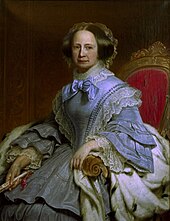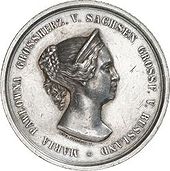Maria Pavlovna

Maria Pavlovna Romanova, Grand Duchess of Russia ( Russian : Мария Павловна Романова ) (* 5 February . Jul / 16th February 1786 . Greg in Pavlovsk in Saint Petersburg ; † 23. June 1859 at Schloss Belvedere in Weimar ) was a member of the house Romanow-Holstein-Gottorp and by marriage Grand Duchess of Saxe-Weimar-Eisenach.
Life

Her parents were the Russian Tsar Paul I (1754-1801) and his wife Sophie Dorothee von Württemberg (1759-1828), a daughter of Duke Friedrich Eugen von Württemberg and Princess Friederike Dorothea Sophia von Brandenburg-Schwedt . She was the younger sister of Tsar Alexander I of Russia . Her sisters were also married to European monarchs; Maria Pawlowna was also the sister of Anna Pawlowna , a queen of the Netherlands , and Katharina Pawlowna , a queen of Württemberg . Tsarina Catherine the Great was her paternal grandmother.
On August 3, 1804, she married the Hereditary Prince Carl Friedrich of Saxe-Weimar in Saint Petersburg . The marriage took place in Saint Petersburg because all ties with Russian grand dukes were sealed by a marriage in Petersburg.


Politically, their presence in Weimar was of great importance. Through her marriage to Carl Friedrich, the small, relatively insignificant and impoverished Duchy of Saxony-Weimar-Eisenach allied itself with Russia and its Tsar dynasty, at that time one of the most powerful and richest families in Europe. Even when she moved into Weimar for the first time as a newlywed she made a great impression when she arrived with a large number of sumptuous gifts from Russia, which were exhibited in the Weimar Castle. On her arrival, in her honor, a large golden M was carved into the rock in a forest and painted, which was visible from afar. The time of their arrival in Weimar in November 1804 coincided with the rise of Napoleon in France, which from there soon threatened almost all states of Europe. For the almost defenseless duchy, which was also allied with Prussia and refused to join the Napoleon-dependent Rhine Confederation after the dissolution of the Old Kingdom in 1806 , its presence was a kind of "life insurance" as it brought Russian protection against French expansionist desires.
After the defeat of Prussia in the double battle of Jena and Auerstedt in 1806, which was fought on Saxon-Weimar soil, Maria Pawlowna fled from Sachsen-Weimar and did not return until the following year. The peace conditions for the duchy were harsh, but the fact that the country was able to maintain its independence was also thanks to Maria Pavlovna, since Napoleon was interested in a compromise with the Russian tsar at this time and therefore had to take Russian interests into account.
During the French Russian campaign , Maria Pavlovna left Weimar again and went to Bohemia , where she placed herself under the protection of Austrian troops. She only returned to Weimar after the Battle of Leipzig . She took part in the Congress of Vienna , which brought Saxony-Weimar-Eisenach the rank of Grand Duchy and significant territorial gains. However, with her wish to have the former Principality of Fulda awarded as an independent rule, she could not prevail.
Her father-in-law, Grand Duke Carl August, died in 1828 and Maria Pavlovna's husband ascended the throne, making her the Grand Duchess.
The Grand Duchess achieved particular importance as a patron of the arts at the Weimar court. She followed in the footsteps of her predecessor Anna Amalia , who once established Weimar's reputation as a “ court of muses ”. But the libraries, which were not only influenced by important writers and scholars such as Johann Wolfgang Goethe , Friedrich Schiller , Johann Gottfried Herder and Christoph Martin Wieland , the music schools and also the painting collections owed much to their generous support. The Grand Duchess had rooms decorated for the writers by well-known painters of her time: Friedrich Preller the Elder decorated the Wieland room and Bernhard von Neher was commissioned for the Goethe and Schiller rooms . For the latter, Woldemar Hermann had to design the pilasters and the medallions. The Duchess Anna Amalia Library in Weimar also has a music collection, although it has been decimated by the fire in 2004 . During the time of the Restoration under Metternich, some artists who were persecuted in other countries owed their asylum to their liberal attitude, as was that of the Grand Duke . The composer Franz Liszt , who became court conductor, was one of them. Not least because of this bundled knowledge, Weimar was a kind of scholarly republic . The industrialization of the small state also fell in Maria Pavlovna's time .
Her husband, Grand Duke Carl Friedrich, died in 1853 and their son Carl Alexander ascended the throne. As the Grand Duchess Mother, she continued to devote herself to her diverse artistic and social projects and also traveled one last time to her Russian homeland. She was buried at the Weimar Historical Cemetery in a Russian Orthodox grave chapel built especially for her next to the Weimar Princely Crypt.
social commitment
Maria Pavlovna also had a heart for the common people, the poor and their problems. She advocated the establishment of a savings bank association and took care of securing the livelihood of women. She used money from her private box for social projects. She was loved and revered by the Weimar people as the "angel of the poor, sick and orphans". She also made the city of Weimar more beautiful by building fountains. The fountain she donated was created by the Berka stonemason Carl Dornberger .
progeny
- Paul Alexander Carl Constantin Friedrich August (1805-1806)
- Marie Luise Alexandrina (1808–1877)
- ⚭ 1827 Prince Carl of Prussia
- Augusta Marie Luise Katharina (1811–1890)
- ⚭ 1829 Prince Wilhelm of Prussia, later King Wilhelm I of Prussia and first German Emperor
- Carl Alexander August Johann (1818–1901), Grand Duke of Saxe-Weimar-Eisenach
- ⚭ 1842 Princess Sophie of Orange-Nassau
Continue to work in the 21st century
- On June 9, 2002, friends of Maria Pawlowna and her work founded the Maria Pawlowna Gesellschaft e. V. in Kromsdorf Castle, which is close to Weimar . In its self-portrayal, the association declares: “The non-profit association is committed to dialogue and encounters in Europe. The society also spans bridges to all continents. ”One focus of the association's work is maintaining the legacy of Stéphane Hessel .
literature
- Non-fiction books:
- Andrej Tchernodarov (Ed.): Princely mothers and daughters between St. Petersburg, Weimar and Berlin . Potsdam 2010.
- Joachim Berger, Joachim von Puttkamer (ed.): From Petersburg to Weimar. Cultural transfers from 1800 to 1860 . Peter Lang, Frankfurt am Main a. a. 2005, ISBN 3-631-54479-0 .
- Jochen Klauß (Ed.): "Your Imperial Highness" Maria Pawlowna. Tsar's daughter at the Weimar court . Deutscher Kunstverlag, Munich 2004, ISBN 3-422-06516-4 (+ 1 CD-ROM, catalog of the Weimar Classics Foundation and art collections for the exhibition of the same name in the Weimar Castle Museum).
- Katja Dmitrieva, Viola Klein (Ed.): Maria Pavlovna. The early diaries of the Hereditary Duchess of Saxe-Weimar-Eisenach . Böhlau, Cologne 2000, ISBN 3-412-13499-6 .
- Detlef Jena: Maria Pawlowna. Grand Duchess at Weimar's court of muses . Styria, Graz 1999, ISBN 3-222-12670-4 .
- Detlef Jena: The Weimar Quartet. The princesses Anna Amalia, Louise, Maria Pavlovna, Sophie . Pustet, Regensburg 2007, ISBN 978-3-7917-2044-9 .
- Franziska Schedewie, Raphael Utz: Russia, Germany and the Wartburg. Political Options and Representation Strategies in Weimar Festival Culture . In: Michael Maurer (Ed.): Festival cultures in comparison. Staging of the religious and the political . Böhlau, Cologne, Weimar, Vienna 2010, pp. 139-158 .
- Rita Seifert: The homage to the arts in the Grand Duchy of Saxony-Weimar-Eisenach: Friedrich Schiller and the Grand Duchess Maria Pawlowna . Weimardruck, Weimar 2004, ISBN 3-930687-55-0 .
- Rita Seifert: Maria Pavlovna. Patron of the arts and social benefactor . Weimarer Verlagsgesellschaft, Weimar 2012, ISBN 3-939964-36-0 .
- Rita Seifert: Private or State ?: Maria Pawlowna and the women in the Grand Duchy of Saxony-Weimar-Eisenach . Weimardruck, Weimar 2005, ISBN 3-930687-49-6 .
- Kuschtewskaja, Tatjana: Russians without Russia. Famous Russian Women in 18 Portraits. Düsseldorf 2012. ISBN 978-3-89978-162-5 .
- Fiction:
- Detlef Jena: The Weimar Tsarina . Bussert & Stadeler, Jena 2004, ISBN 3-932906-47-0 ( short story).
Web links
- Literature by and about Maria Pawlowna in the catalog of the German National Library
- Works by and about Maria Pawlowna in the German Digital Library
- Maria Pavlovna. In: FemBio. Women's biography research (with references and citations).
- Lexical article at MUGI - "Music and Gender on the Internet"
- VI Fedortschenko: The House of the Romanovs: Biographical Encyclopedia (Дом Романовых: энциклопедия биографий), Olma-Press, 2003, page 174 (Russian)
- IS Semyonov: Christian Dynasties in Europe (Христианские династии Европы), Olma Media Group, 2002, page 125 (Russian)
- The Orthodox Church in Weimar burial place for Maria Pavlovna
- Pavlovna, Maria . Sophie Drinker Institute
Individual evidence
- ↑ Woldemar Hermann; Eckhart Schleinitz (ed.); Michael Schleinitz (Ed.): Diary of my sphere of activity in architecture . Verlag Notschriften, Radebeul 2006, ISBN 978-3-933753-88-5 , p. 66 f.
- ^ Maria Pavlovna Society
- ↑ ThILLM Bad Berka (Hrsg.): The dignity of the people ... Stéphane Hessel October 20, 1917 to February 27, 2013, Weimar 2013 , 5th ed.
| personal data | |
|---|---|
| SURNAME | Maria Pavlovna |
| ALTERNATIVE NAMES | Romanow-Holstein-Gottorp, Maria |
| BRIEF DESCRIPTION | Grand Duchess of Saxe-Weimar-Eisenach |
| DATE OF BIRTH | February 16, 1786 |
| PLACE OF BIRTH | Pavlovsk near Saint Petersburg |
| DATE OF DEATH | June 23, 1859 |
| Place of death | Belvedere , Weimar |


